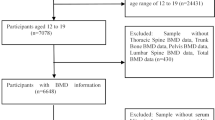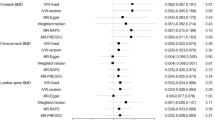Abstract
Background
Vitamin B12, essential for bone health, has an unclear relationship with bone mineral density (BMD) in adolescents. This study examined this association.
Methods
Data were drawn from the National Health and Nutrition Examination Survey (NHANES). Dietary vitamin B12 intake was assessed via 24-hour dietary recall, and BMD at the lumbar spine and femur was measured using dual-energy X-ray absorptiometry (DXA). Multiple regression models were employed to assess the relationship between vitamin B12 intake and BMD, adjusting for confounders. Subgroup analyses and interaction tests were performed, followed by sensitivity analyses, including multiple imputation for missing covariates data.
Results
Among 2531 adolescents aged 12–19, higher dietary vitamin B12 intake was associated with greater BMD at both the lumbar spine and femur. A 5 mcg/day increase in vitamin B12 intake corresponded to a 12.60 mg/cm² increase in lumbar spine BMD (P = 0.009) and a 20.08 mg/cm² increase in femoral BMD (P = 0.001). Participants in the highest tertile of intake had significantly higher BMD than those in the lowest tertile. Subgroup and sensitivity analyses showed consistent results.
Conclusions
Higher vitamin B12 intake may support better BMD in adolescents, but further studies are needed to confirm these findings.
Impact
-
Higher dietary vitamin B12 intake may support bone health in adolescents during a critical growth phase.
-
This study provides new evidence linking vitamin B12 intake with bone mineral density in a large, nationally representative cohort.
-
The findings highlight the potential need for targeted nutritional strategies to optimize adolescent bone health.
-
Future research should confirm these results and explore sex- and age-specific differences.
This is a preview of subscription content, access via your institution
Access options
Subscribe to this journal
Receive 14 print issues and online access
$259.00 per year
only $18.50 per issue
Buy this article
- Purchase on SpringerLink
- Instant access to full article PDF
Prices may be subject to local taxes which are calculated during checkout


Similar content being viewed by others
Data availability
The data utilized in this study were obtained from the NHANES, a publicly available dataset provided by the CDC. The data can be accessed freely at https://www.cdc.gov/nchs/nhanes/index.htm. All relevant data supporting the findings of this study are available within the NHANES database.
References
Khan, N. M. et al. Enhanced osteogenic potential of iPSC-derived mesenchymal progenitor cells following genome editing of GWAS variants in the RUNX1 gene. Bone Res. 12, 70 (2024).
Haseltine, K. N. et al. Bone mineral density: clinical relevance and quantitative assessment. J. Nucl. Med. 62, 446–454 (2021).
Pan, K., Zhang, C., Yao, X. & Zhu, Z. Association between dietary calcium intake and BMD in children and adolescents. Endocr. Connect. 9, 194–200 (2020).
Laranjeira, A. C., Berger, S., Kohlbrenner, T., Greter, N. R. & Hajnal, A. Nutritional vitamin B12 regulates RAS/MAPK-mediated cell fate decisions through one-carbon metabolism. Nat. Commun. 15, 8178 (2024).
Zhao, J., Lu, Q. & Zhang, X. Associations of serum vitamin B12 and its biomarkers with musculoskeletal health in middle-aged and older adults. Front. Endocrinol.15, 1387035 (2024).
Adhish, M. & Manjubala, I. Integrative in-silico and in-vitro analysis of taurine and vitamin B12 in modulating PPARγ and Wnt signaling in hyperhomocysteinemia-induced osteoporosis. Biol. Direct. 19, 141 (2024).
Mishra, A. et al. Exploring the effects of homocysteine metabolism in osteoporosis management in Indian adult females. Int. J. Mol. Epidemiol. Genet 15, 31–43 (2024).
Hussain, S. I. B., AlKhenizan, A., Mahmoud, A. & Qashlaq, H. The correlation between vitamin B12 and folate levels and bone mineral density among the Saudi population in a primary care setting. J. Fam. Med. Prim. Care 12, 1063–1068 (2023).
Malczewska-Lenczowska, J. et al. The relationship between bone health parameters, vitamin D and iron status, and dietary calcium intake in young males. Nutrients 16, 215 (2024).
Passarelli, S. et al. Global estimation of dietary micronutrient inadequacies: a modelling analysis. Lancet Glob. Health 12, e1590–e1599 (2024).
Wei J. et al. Opposing effects of nutritional supply on bone health at different ages: based on the National Health and Nutrition Examination Survey database. Nutrients 16, https://doi.org/10.3390/nu16060758 (2024).
Xiong, X. et al. Association between perfluoroalkyl substances concentration and bone mineral density in the US adolescents aged 12-19 years in NHANES 2005-2010. Front. Endocrinol. 13, 980608 (2022).
Lu, M., Liu, Y., Shao, M., Tesfaye, G. C. & Yang, S. Associations of iron intake, serum iron and serum ferritin with bone mineral density in women: The National Health and Nutrition Examination Survey, 2005–2010. Calcif. Tissue Int. 106, 232–238 (2020).
Fan, Y., Ni, S. & Zhang, H. Association between Healthy Eating Index-2015 total and component food scores with osteoporosis in middle-aged and older Americans: a cross-sectional study with U.S. National Health and Nutrition Examination Survey. Osteoporos. Int. 33, 921–929 (2022).
Aldieri, A. et al. DXA-based statistical models of shape and intensity outperform aBMD hip fracture prediction: a retrospective study. Bone 182, 117051 (2024).
Thompson, F. E. et al. Comparison of interviewer-administered and automated self-administered 24-hour dietary recalls in 3 diverse integrated health systems. Am. J. Epidemiol. 181, 970–978 (2015).
Ahluwalia, N., Dwyer, J., Terry, A., Moshfegh, A. & Johnson, C. Update on NHANES dietary data: focus on collection, release, analytical considerations, and uses to inform public policy. Adv. Nutr. 7, 121–134 (2016).
Li, J., Huang, J., Lv, Y. & Ji, H. Association between dietary intakes of B vitamins and nonalcoholic fatty liver disease in postmenopausal women: a cross-sectional study. Front. Nutr. 10, 1272321 (2023).
Haddad, E. H., Jaceldo-Siegl, K., Oda, K. & Fraser, G. E. Associations of circulating methylmalonic acid and vitamin B-12 biomarkers are modified by vegan dietary pattern in adult and elderly participants of the Adventist Health Study 2 calibration study. Curr. Dev. Nutr. 4, nzaa008 (2020).
Sh M. et al. Dietary intake of calcium and magnesium in relation to severe headache or migraine. Front. Nutrition. 8, https://doi.org/10.3389/fnut.2021.653765 (2021).
Liu, H., Wang, Q., Dong, Z. & Yu, S. Dietary zinc intake and migraine in adults: a cross-sectional analysis of the National Health and Nutrition Examination Survey 1999–2004. Headache 63, 127–135 (2023).
CDC. The SAS Program for CDC growth charts that includes the extended BMI Calculations. (accessed 15 September 2024); https://www.cdc.gov/nccdphp/dnpao/growthcharts/resources/sas.htm.
CDC. About Child & Teen BMI. (accessed 15 September 2024); https://www.cdc.gov/healthyweight/assessing/bmi/childrens/about_childrens_bmi.
Agricultural Research Service, US Department of Agriculture. What we eat in america: data tables. (accessed 17 September 2024); https://www.ars.usda.gov/northeast-area/beltsville-md-bhnrc/beltsville-human-nutrition-research-center/food-surveysresearch-group/docs/wweia-data-tables/.
Liu H. et al. The association between serum copper and bone mineral density among adolescents aged 12 to 19 in the United States. Nutrients 16, https://doi.org/10.3390/nu16030453 (2024).
Xiong, X. et al. Association between perfluoroalkyl substances concentration and bone mineral density in the US adolescents aged 12–19 years in NHANES 2005-2010. Front. Endocrinol. 13, 980608 (2022).
Wan, Z. et al. Association of serum 25-hydroxyvitamin D concentrations with all-cause and cause-specific mortality among individuals with diabetes. Diab. Care 44, 350–357 (2021).
Wu, J., Jia, C., Zhang, Z., Hou, Z. & Cui, Y. The relationship between dietary total flavonoids and thyroid function in U.S. adults, NHANES 2007–2010. PLoS ONE 19, e0303169 (2024).
Zeng, J. et al. Association between a metabolic score for insulin resistance and hypertension: results from National Health and Nutrition Examination Survey 2007-2016 analyses. Front. Endocrinol.15, 1369600 (2024).
Clements, M. et al. A 2-year randomised controlled trial with low-dose B-vitamin supplementation shows benefits on bone mineral density in adults with lower B12 status. J. Bone Min. Res. 37, 2443–2455 (2022).
Pawlak, R. Vitamin B12 status is a risk factor for bone fractures among vegans. Med. Hypotheses 153, 110625 (2021).
Grili P. P. et al. Nutrient patterns and risk of osteopenia in postmenopausal women. Nutrient 15, https://doi.org/10.3390/nu15071670 (2023).
Dhonukshe-Rutten, R. A. M. et al. Vitamin B-12 status is associated with bone mineral content and bone mineral density in frail elderly women but not in men. J. Nutr. 133, 801–807 (2003).
Bailey, R. L. et al. B-vitamin status and bone mineral density and risk of lumbar osteoporosis in older females in the United States. Am. J. Clin. Nutr. 102, 687–694 (2015).
Hsieh, R. L. et al. Associations between plasma folate and vitamin B12, blood lead, and bone mineral density among adults and elderly who received a health examination. Nutrients 14, 911 (2022).
Macêdo, L. L. G., Carvalho, C. M. R. G., Cavalcanti, J. C. & Freitas, B. J. E. S. A. Vitamin B12, bone mineral density and fracture risk in adults: a systematic review. Rev. Assoc. Med. Bras. 63, 801–809 (2017).
Clemens, T. L. Vitamin B12 deficiency and bone health. N. Engl. J. Med. 371, 963–964 (2014).
Roman-Garcia, P. et al. Vitamin B12-dependent taurine synthesis regulates growth and bone mass. J. Clin. Investig. 124, 2988–3002 (2014).
Cagnacci, A. et al. Relation of folates, vitamin B12 and homocysteine to vertebral bone mineral density change in postmenopausal women. A five-year longitudinal evaluation. Bone 42, 314–320 (2008).
Liang, J. et al. Association between joint physical activity and dietary quality and lower risk of depression symptoms in US adults: cross-sectional NHANES Study. JMIR Public Health Surveill. 9, e45776 (2023).
Li, T. et al. Associations of diet quality and heavy metals with obesity in adults: a cross-sectional study from National Health and Nutrition Examination Survey (NHANES). Nutrients 14, 4038 (2022).
Zhu, T., Lu, X. T., Liu, Z. Y. & Zhu, H. L. Dietary linoleic acid and the ratio of unsaturated to saturated fatty acids are inversely associated with significant liver fibrosis risk: a nationwide survey. Front. Nutr. 9, 938645 (2022).
Acknowledgements
We gratefully acknowledge the contributions of Jie Liu from the Department of Vascular and Endovascular Surgery at the Chinese PLA General Hospital and Qilin Yang from the Second Affiliated Hospital of Guangzhou Medical University. Their statistical support, study design consultations, and comments on the manuscript were invaluable.
Author information
Authors and Affiliations
Contributions
Keyi Li: Writing – Conceptualization, original draft, Software, Resources, Project administration, Methodology, Investigation, Formal analysis, Data curation. Chunhong Guo: Writing – review & editing, Methodology, Investigation. YiShan Yin: Writing – review & editing, Supervision. Xiaojun Chen: Writing – review & editing, Supervision. Mingxuan Zheng: Conceptualization, Methodology, Writing – original draft, Software, Investigation, Data curation. All authors read and approved the final manuscript.
Corresponding author
Ethics declarations
Competing interests
The authors declare no competing interests.
Ethics approval and consent to participate
This study utilized publicly available data from the NHANES, which is conducted by the CDC. NHANES received approval from the National Center for Health Statistics (NCHS) Research Ethics Review Board, and informed consent was obtained from all participants or their guardians. No additional ethical approval was required for this secondary analysis, as the data were fully anonymized and de-identified prior to access.
Additional information
Publisher’s note Springer Nature remains neutral with regard to jurisdictional claims in published maps and institutional affiliations.
Supplementary information
Rights and permissions
Springer Nature or its licensor (e.g. a society or other partner) holds exclusive rights to this article under a publishing agreement with the author(s) or other rightsholder(s); author self-archiving of the accepted manuscript version of this article is solely governed by the terms of such publishing agreement and applicable law.
About this article
Cite this article
Li, K., Guo, C., Yin, Y. et al. Association between dietary vitamin B12 intake and bone mineral density in adolescents. Pediatr Res (2025). https://doi.org/10.1038/s41390-025-04150-6
Received:
Revised:
Accepted:
Published:
DOI: https://doi.org/10.1038/s41390-025-04150-6



